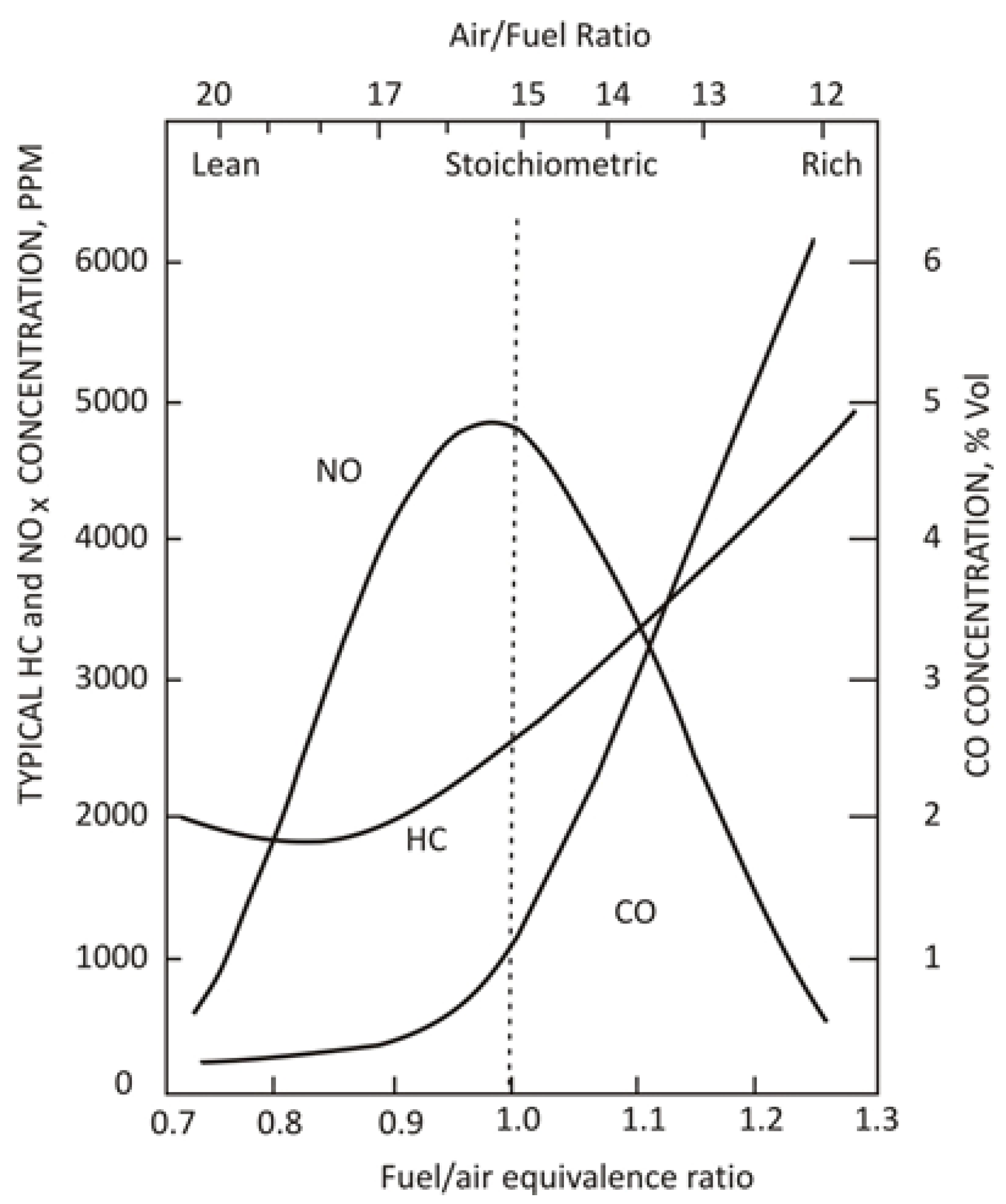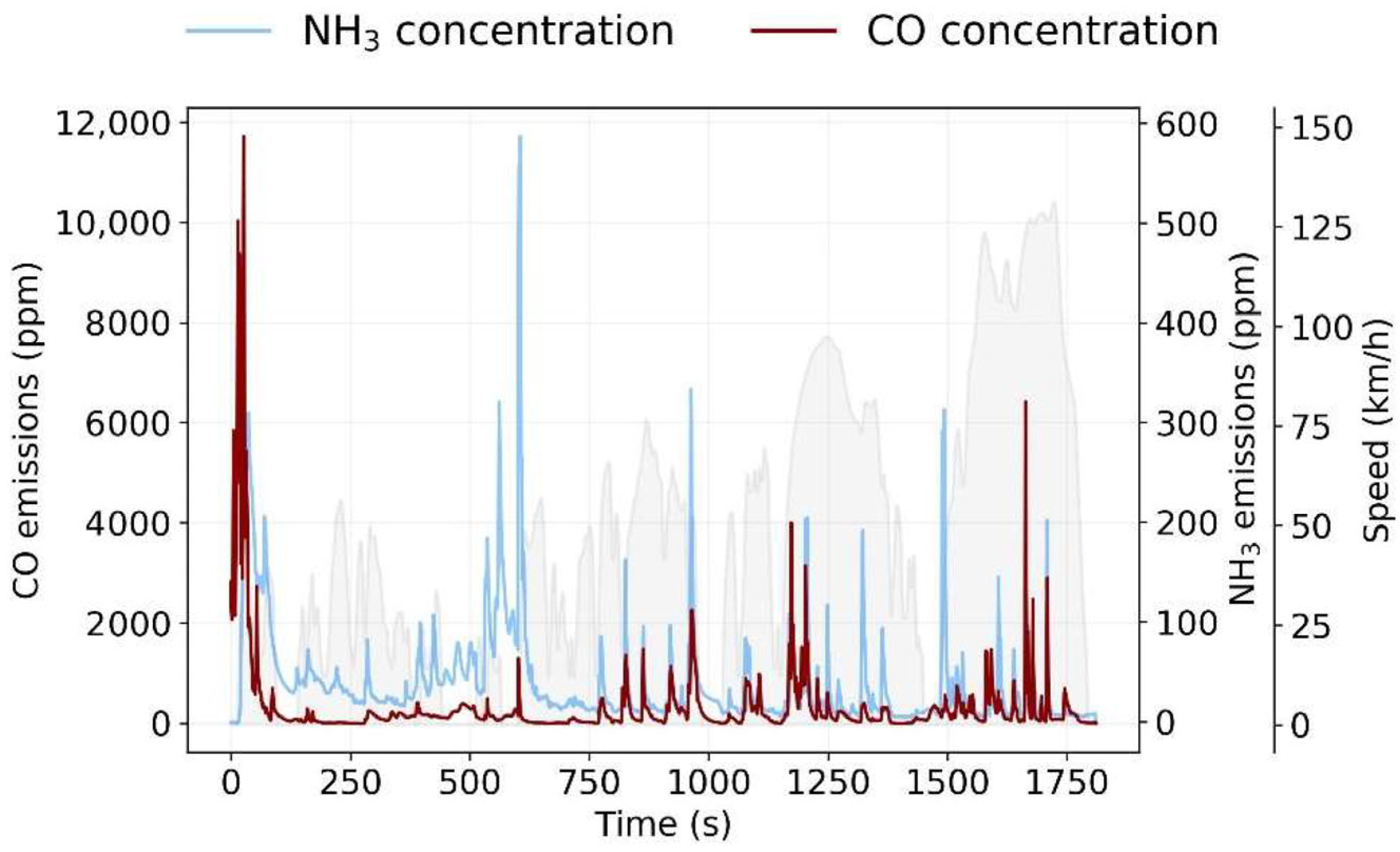Parameters Characterizing the Performance of Automotive Electronic Control Systems on Petrol Engine Emissions †
Abstract
1. Introduction
2. Materials and Methods

3. Conclusions
Author Contributions
Funding
Institutional Review Board Statement
Informed Consent Statement
Data Availability Statement
Conflicts of Interest
References
- European Environment Agency, Emissions of Air Pollutants from Transport in Europe, Published 28 October 2024. Available online: https://www.eea.europa.eu/en/analysis/indicators/emissions-of-air-pollutants-from?activeAccordion=ecdb3bcf-bbe9-4978-b5cf-0b136399d9f8 (accessed on 26 April 2025).
- Mladenov, G.; Damyanov, I.; Saliev, D.; Ionchev, E. Design of Measurement System for Vehicle Emissions in Real Road Conditions. In Proceedings of the 2022 30th National Conference with International Participation (TELECOM), Sofia, Bulgaria, 27–28 October 2022; pp. 1–4. [Google Scholar] [CrossRef]
- Suarez-Bertoa, R.; Zardini, A.A.; Astorga, C. Ammonia exhaust emissions from spark ignition vehicles over the New European Driving Cycle. Atmos. Environ. 2014, 97, 43–53. [Google Scholar] [CrossRef]
- Suarez-Bertoa, R.; Zardini, A.A.; Lilova, V.; Meyer, D.; Nakatani, S.; Hibel, F.; Ewers, J.; Clairotte, M.; Hill, L.; Astorga, C. Intercomparison of real-time tailpipe ammonia measurements from vehicles tested over the new world-harmonized light-duty vehicle test cycle (WLTC). Environ. Sci. Pollut. Res. 2015, 22, 7450–7460. [Google Scholar] [CrossRef] [PubMed]
- Miletiev, R.; Yordanov, R.; Iontchev, E.; Damyanov, I. Real-time online measurement of automotive pollution emissions. In Proceedings of the 32nd International Scientific Conference Electronics, ET 2023, Sozopol, Bulgaria, 13–15 September 2023; Available online: https://www.scopus.com/inward/record.uri?eid=2-s2.0-85176105029&doi=10.1109%2fET59121.2023.10279312&partnerID=40&md5=6ce6759762c85d7cdb478756c1a8b199 (accessed on 26 April 2025). [CrossRef]
- Suarez-Bertoa, R.; Astorga, C. Isocyanic acid and ammonia in vehicle emissions. Transp. Res. Part D Transp. Environ. 2016, 49, 259–270. [Google Scholar] [CrossRef]
- Kean, A.; Littlejohn, D.; Ban-Weiss, G.; Harley, R.; Kirchstetter, T.; Lunden, M. Trends in on-road vehicle emissions of ammonia. Atmos. Environ. 2009, 43, 1565–1570. [Google Scholar] [CrossRef]
- Heeb, N.V.; Saxer, C.J.; Forss, A.-M.; Brühlmann, S. Trends of NO-, NO2-, and NH3-emissions from gasoline-fueled Euro-3- to Euro-4-passenger cars. Atmos. Environ. 2008, 42, 2543–2554. [Google Scholar] [CrossRef]
- Suarez-Bertoa, R.; Mendoza-Villafuerte, P.; Riccobono, F.; Vojtisek, M.; Pechout, M.; Perujo, A.; Astorga, C. On-road measurement of NH 3 emissions from gasoline and diesel passenger cars during real world driving conditions. Atmos. Environ. 2017, 166, 488–497. [Google Scholar] [CrossRef]
- Selleri, T.; Melas, A.; Bonnel, P.; Suarez-Bertoa, R. NH3 and CO Emissions from Fifteen Euro 6d and Euro 6d-TEMP Gasoline-Fuelled Vehicles. Catalysts 2022, 12, 245. [Google Scholar] [CrossRef]
- Stradling, R.; Williams, J.; Hamje, H.; Rickeard, D. Effect of Octane on Performance, Energy Consumption and Emissions of Two Euro 4 Passenger Cars. Transp. Res. Procedia 2016, 14, 3159–3168. [Google Scholar] [CrossRef]
- Saliev, D.; Damyanov, I. Vehicles acceleration rate study for intergreen time of a signal cycle compute. AIP Conf. Proc. 2022, 2449, 050007. [Google Scholar] [CrossRef]
- Mladenov, G.; Saliev, D.; Damyanov, I.; Valkovski, T.; Iontchev, E. Measurement of vehicle emissions in real road conditions part I. Methodology for measuring emissions from vehicles. AIP Conf. Proc. 2024, 2980, 050006. [Google Scholar] [CrossRef]
- Mladenov, G.; Damyanov, I.; Saliev, D.; Valkovski, T.; Radev, M. Measurement of vehicle emissions in real road conditions part II. Results and analysis. AIP Conf. Proc. 2024, 2980, 050007. [Google Scholar] [CrossRef]
- Santos, N.D.S.A.; Alvarez, C.E.C.; Roso, V.R.; Baeta, J.G.C.; Valle, R.M. Lambda load control in spark ignition engines, a new application of prechamber ignition systems. Energy Convers. Manag. 2021, 236, 114018. Available online: https://www.sciencedirect.com/science/article/pii/S0196890421001941 (accessed on 26 April 2025). [CrossRef]
- Ambarev, K.; Taneva, S. Study of the Influence of Road Resistance on the Fuel Consumption of a Passenger Car with an Automatic Transmission. Vide Tehnol. Resur.—Environ. Technol. Resour. 2023, 3, 15–19. Available online: https://www.scopus.com/inward/record.uri?eid=2-s2.0-85170638702&doi=10.17770%2fetr2023vol3.7273&partnerID=40&md5=86280c9638e08e927c38b552a5056005 (accessed on 26 April 2025). [CrossRef]
- Dimitrov, K.; Damyanov, I. Thermographic Analysis of Gasoline Engine Exhaust Manifold for Smart City Garage. In Proceedings of the 2019 International Conference on Creative Business for Smart and Sustainable Growth (CREBUS), Sandanski, Bulgaria, 18–21 March 2019; pp. 1–4. [Google Scholar] [CrossRef]
- Xie, F.-X.; Li, X.-P.; Wang, X.-C.; Su, Y.; Hong, W. Research on using EGR and ignition timing to control load of a spark-ignition engine fueled with methanol. Appl. Therm. Eng. 2013, 50, 1084–1091. Available online: https://www.sciencedirect.com/science/article/pii/S1359431112005248 (accessed on 26 April 2025). [CrossRef]
- Tashev, A.; Stoyanov, Y. Analysis of the CNG impact on some of the combustion parameters of dual-fuel compression ignition engines. AIP Conf. Proc. 2024, 3078, 050008. Available online: https://www.scopus.com/inward/record.uri?eid=2-s2.0-85192243383&doi=10.1063%2f5.0208335&partnerID=40&md5=6096a0479a08b3da356116a85fddfff1M (accessed on 26 April 2025). [CrossRef]
- Gumus, M. Effects of volumetric efficiency on the performance and emissions characteristics of a dual fueled (gasoline and LPG) spark ignition engine. Fuel Process. Technol. 2011, 92, 1862–1867. Available online: https://www.sciencedirect.com/science/article/pii/S0378382011001597 (accessed on 26 April 2025). [CrossRef]
- Wang, Y.; Li, H.; Zhou, J.; Zhou, L. Study of HCCI-DI combustion and emissions in a DME engine. Fuel 2009, 88, 2255–2261. Available online: https://www.sciencedirect.com/science/article/pii/S0016236109002427 (accessed on 26 April 2025). [CrossRef]
- Horn, R.; Williams, K.A.; Degenstein, N.J.; Schmidt, L.D. Syngas by catalytic partial oxidation of methane on rhodium: Mechanistic conclusions from spatially resolved measurements and numerical simulations. J. Catal. 2006, 242, 92–102. Available online: https://www.sciencedirect.com/science/article/pii/S002195170600176X (accessed on 26 April 2025). [CrossRef]
- Williams, K.A.; Schmidt, L.D. Catalytic autoignition of higher alkane partial oxidation on Rh-coated foams. Appl. Catal. A Gen. 2006, 299, 30–45. Available online: https://www.sciencedirect.com/science/article/pii/S0926860X05007672 (accessed on 26 April 2025). [CrossRef]
- Nelson, P.F.; Quigley, S.M. The hydrocarbon composition of exhaust emitted from gasoline fueled vehicles. Atmos. Environ. (1967) 1984, 18, 79–87. Available online: https://www.sciencedirect.com/science/article/pii/0004698184902300 (accessed on 26 April 2025). [CrossRef]
- Ambarev, K.; Nikolov, V. Experimental Study of Toxic Components in the Exhaust Gases During the Operation of a Car Engine with Gasoline and LPG. Vide Tehnol. Resur.—Environ. Technol. Resour. 2023, 3, 20–23. Available online: https://www.scopus.com/inward/record.uri?eid=2-s2.0-85170644980&doi=10.17770%2fetr2023vol3.7304&partnerID=40&md5=256af2a0e3cbaf6cc02e9bf25cda13e5 (accessed on 26 April 2025). [CrossRef]
- Payri, F.; Bermúdez, V.R.; Tormos, B.; Linares, W.G. Hydrocarbon emissions speciation in diesel and biodiesel exhausts. Atmos. Environ. 2009, 43, 1273–1279. Available online: https://ui.adsabs.harvard.edu/abs/2009AtmEn..43.1273P/abstract (accessed on 26 April 2025). [CrossRef]
- Available online: https://archive.nptel.ac.in/content/storage2/courses/112104033/lecture3/3_3.htm (accessed on 24 April 2025).
- Zhong, X.L. Study on Control of MPI Gasoline Engine in Transient Condition Based on Fuel Film Model. Ph.D. Thesis, College of Automotive Engineering, Jilin University, Changchun, China, 2007. [Google Scholar]
- Wu, S. Gasoline Engine Management System; Beijing Institute of Press: Beijing, China, 2002; p. 27. [Google Scholar]
- Claude, D.; Rachid, T.; Najat, M.M.; Duprez, D. Oxygen storage capacity easurements of three-way catalysts under transient conditions. Appl. Catal. A Gen. 2002, 223, 287–299. [Google Scholar]
- Harmsen, J.M.A.; Hoebink, J.H.B.J.; Schouten, J.C. Transient kinetic modelling of the ethylene and carbon monoxide oxidation over a commercial automotive exhaust gas catalyst. Ind. Eng. Chem. Res. 2000, 39, 599–609. [Google Scholar] [CrossRef]
- Harmsen, J.M.A.; Hoebink, J.H.B.J.; Schouten, J.C. Acetylene and carbon monoxide oxidation over a commercial exhaust gas catalyst: Kinetic modeling of transient experiments. Chem. Eng. Sci. 2001, 56, 2019–2035. [Google Scholar] [CrossRef]
- Harmsen, J.M.A.; Hoebink, J.H.B.J.; Schouten, J.C. Kinetic modeling of transient NO reduction by CO in the presence of O2 over an automotive exhaust gas catalyst. Stud. Surf. Sci. Catal. 2001, 133, 349–356. [Google Scholar] [CrossRef]
- James, C.P.J.; Keneth, R.M. Model-based OBD for Three-Way Catalyst Systems. In Proceedings of the SAE 2004 World Congress and Exhibition, Detroit, MI, USA, 8–11 March 2004. [Google Scholar]
- Wang, Y.J.; Wang, Z.S.; Han, Y.Q.; Liu, Z.C.; Ren, L.R. On-board diagnostic function calibration of 3-way catalyst. J. Jilin Univ. (Eng. Technol. Ed.) 2008, 38, 786–790. [Google Scholar]

Disclaimer/Publisher’s Note: The statements, opinions and data contained in all publications are solely those of the individual author(s) and contributor(s) and not of MDPI and/or the editor(s). MDPI and/or the editor(s) disclaim responsibility for any injury to people or property resulting from any ideas, methods, instructions or products referred to in the content. |
© 2025 by the authors. Licensee MDPI, Basel, Switzerland. This article is an open access article distributed under the terms and conditions of the Creative Commons Attribution (CC BY) license (https://creativecommons.org/licenses/by/4.0/).
Share and Cite
Konakchiev, H.; Dimitrov, E. Parameters Characterizing the Performance of Automotive Electronic Control Systems on Petrol Engine Emissions. Eng. Proc. 2025, 100, 41. https://doi.org/10.3390/engproc2025100041
Konakchiev H, Dimitrov E. Parameters Characterizing the Performance of Automotive Electronic Control Systems on Petrol Engine Emissions. Engineering Proceedings. 2025; 100(1):41. https://doi.org/10.3390/engproc2025100041
Chicago/Turabian StyleKonakchiev, Hristo, and Evgeni Dimitrov. 2025. "Parameters Characterizing the Performance of Automotive Electronic Control Systems on Petrol Engine Emissions" Engineering Proceedings 100, no. 1: 41. https://doi.org/10.3390/engproc2025100041
APA StyleKonakchiev, H., & Dimitrov, E. (2025). Parameters Characterizing the Performance of Automotive Electronic Control Systems on Petrol Engine Emissions. Engineering Proceedings, 100(1), 41. https://doi.org/10.3390/engproc2025100041




